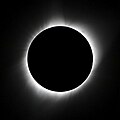| Annular eclipse | |
| Gamma | −0.9673 |
|---|---|
| Magnitude | 0.9277 |
| Maximum eclipse | |
| Duration | 319 s (5 min 19 s) |
| Coordinates | 60°42′S134°24′E / 60.7°S 134.4°E |
| Max. width of band | 1,083 km (673 mi) |
| Times (UTC) | |
| Greatest eclipse | 7:55:50 |
| References | |
| Saros | 119 (61 of 71) |
| Catalog # (SE5000) | 9356 |
An annular solar eclipse occurred at the Moon's ascending node of orbit on Monday, March 7, 1932, [1] with a magnitude of 0.9277. A solar eclipse occurs when the Moon passes between Earth and the Sun, thereby totally or partly obscuring the image of the Sun for a viewer on Earth. An annular solar eclipse occurs when the Moon's apparent diameter is smaller than the Sun's, blocking most of the Sun's light and causing the Sun to look like an annulus (ring). An annular eclipse appears as a partial eclipse over a region of the Earth thousands of kilometres wide. Occurring about 3.6 days before apogee (on March 10, 1932, at 22:00 UTC), the Moon's apparent diameter was smaller. [2]
Contents
- Eclipse details
- Eclipse season
- Related eclipses
- Eclipses in 1932
- Metonic
- Tzolkinex
- Half-Saros
- Tritos
- Solar Saros 119
- Inex
- Triad
- Solar eclipses of 1931–1935
- Saros 119
- Metonic series
- Tritos series
- Inex series
- Notes
- References
Annularity was visible from parts of Antarctica and southern Tasmania. A partial eclipse was visible for parts of Antarctica, Australia, and Southeast Asia.

































































































